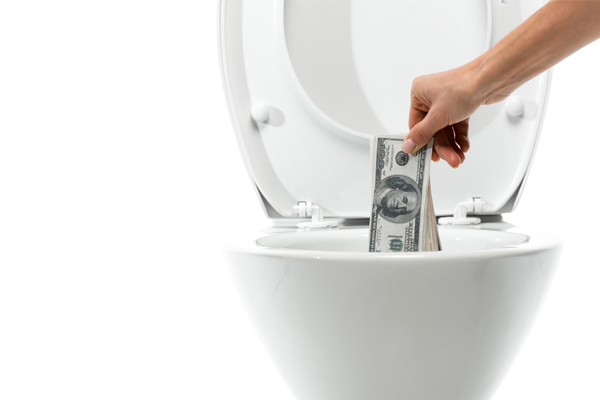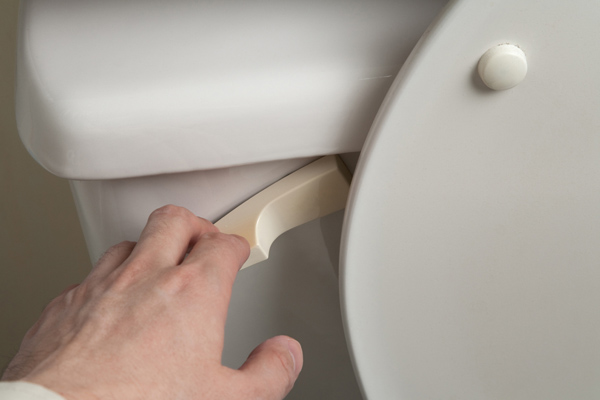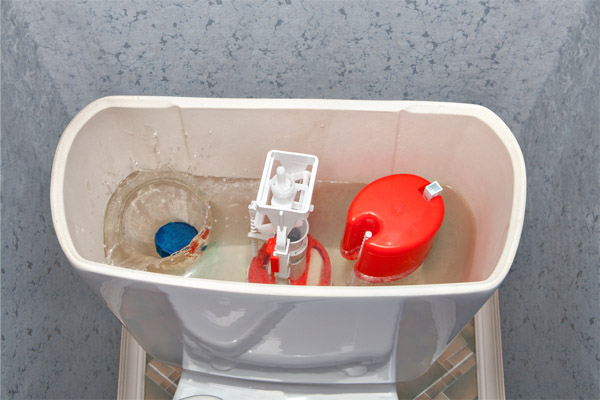4 Things to Try if Your Toilet is Continuously Running

A toilet leak, much like a leaky faucet, wastes many gallons of clean water every day. This isn’t an environmentally sound situation. It can also majorly drive up your water bill. In most cases, the main reason behind a leaky toilet is its water tank, an easy do-it-yourself repair. However, you need to have a general idea of how to fix a toilet that keeps running.
First, you need to make sure that this is actually what you’re dealing with. It is typically easy to spot a leaky toilet because you will hear a running or trickling water noise. You may also see water flowing from under the bowl’s rim. If your toilet doesn’t show any of these symptoms, but you suspect you have a leaky toilet, you can try testing if this is the case. Add several drops of food coloring or colored dye into the water tank. Wait for about 30 minutes, and do not use the toilet while you wait. If the water in the bowl stays clear, then the issue isn’t a leaking toilet. However, if the water in the bowl turns the same color as the dye you put in the water tank, you have a leaky toilet in your hands. Keep reading to explore more plumbing tips for toilet issues.
How To Repair A Toilet That Keeps Running
Contents
The good news is that some circumstances make it easy enough for you to repair a toilet that keeps running. Here are four steps you can take:
Check The Flush Handle Or Flapper

A flush handle that is old or corroded may not work as well as before. When you flush, the handle lifts the arm in the tank, pulling the lift chain or wire linked to the flapper. Water is released into the bowl when the flapper is up. The flapper closes after this, and the water is sealed inside the tank.
If the flush handle doesn’t return to its initial state after you flush, the flapper remains open. This means the water is continuously released into the bowl. Adjust the handle so it returns to its original position after flushing. See if this resolves the issue.
Check if there are any holes or cracks in the flapper or valve seals next. You need to replace the flapper if this is the case. You can find this component in local hardware stores. They are also easy to replace.
Check The Float Arm And Ball In The Toilet Tank

Open the water tank located behind the toilet and examine the float ball. It is a plastic ball that’s as big as a softball and is connected to the float arm. The float ball rises with the tank’s water level. Flushing means the float ball will reach a specific level, and the intel valve will close to stop the water flow. You may need to make float adjustments, so it is at the right level. To do this, twist the screw on top of the ballcock to ensure that the ball is in the correct position.
Moreover, inspect the float ball for cracks and holes. A cracked ball will sink, signaling the toilet to let more water into the tank. The excess water will go through an overflow tube directed to the bowl. This may be what is causing the running water noise. The float and rod need to be replaced if the ball has any holes and cracks.
Try raising the float arm to see if the water stops. You can adjust and bend the arm to allow space between the ball and the tank’s wall. This helps ensure that the float ball is in the correct position inside the tank.
Check The Fill Valve
A fill valve that leaks will release water into the tank, which overflows into the toilet bowl. Flush the toilet to determine if this is the case. This helps you see if you have a fill valve that’s leaking. Raise the float arm as water fills the tank. This should prevent the water from flowing. Adjust or bend the float arm, so the tank stops filling with water when it is around an inch or less below the top section of the overflow pipe. Replace the fill valve if water keeps leaking from it. A new fill valve comes with a manual to help you how to replace the old fill valve with a new unit.
Adjust The Position Of The Fill Tube
A fill or refill tube is a pliable plastic tube linked to the fill valve. It is crucial in the toilet’s refill mechanism. Ideally, it should be placed over the overflow tube where a clip keeps it in place. Ensure that the fill tube is correctly positioned. If not, it will let the water flow into the toilet bowl constantly. You can stop the flow by adjusting the fill tube’s position.
What To Do If Your Toilet Keeps Running
Some toilet issues must never be approached as a do-it-yourself project. Make sure to call a professional plumber if the problem persists or worsens or if you aren’t sure what to do. A plumber can examine the toilet and identify the specific problem. This way, they can recommend the best solution to resolve the issue. Having a professional assist you helps prevent the problem from happening again and ensures that the toilet remains in good condition for a long time.
Call R.F. Ohl For All Of Your Plumbing Requirements

R.F. Ohl is one of the most trusted plumbing companies in the Poconos and the Lehigh Valley, Pennsylvania. Do not hesitate to call R.F. Ohl when you need reliable plumbing services. We offer a variety of plumbing services, including faucet upgrades, toilet repairs and replacements, clogged drain repairs, water leak repairs, and more. We always provide a wide range of solutions when possible for plumbing repairs so that you can choose the best one for your home and budget.
Rest assured, we have the most competitive rates and the best plumbing services in the northeastern Pennsylvania area. All our plumbers have the expertise and the proper licenses to ensure you are satisfied with our work. We provide guarantees for all of our work. Be sure to call R.F. Ohl today to schedule your free estimate. Click the link to view our service area.
Click here to contact us today or give us a call at (610) 377-1098 if you have any questions.